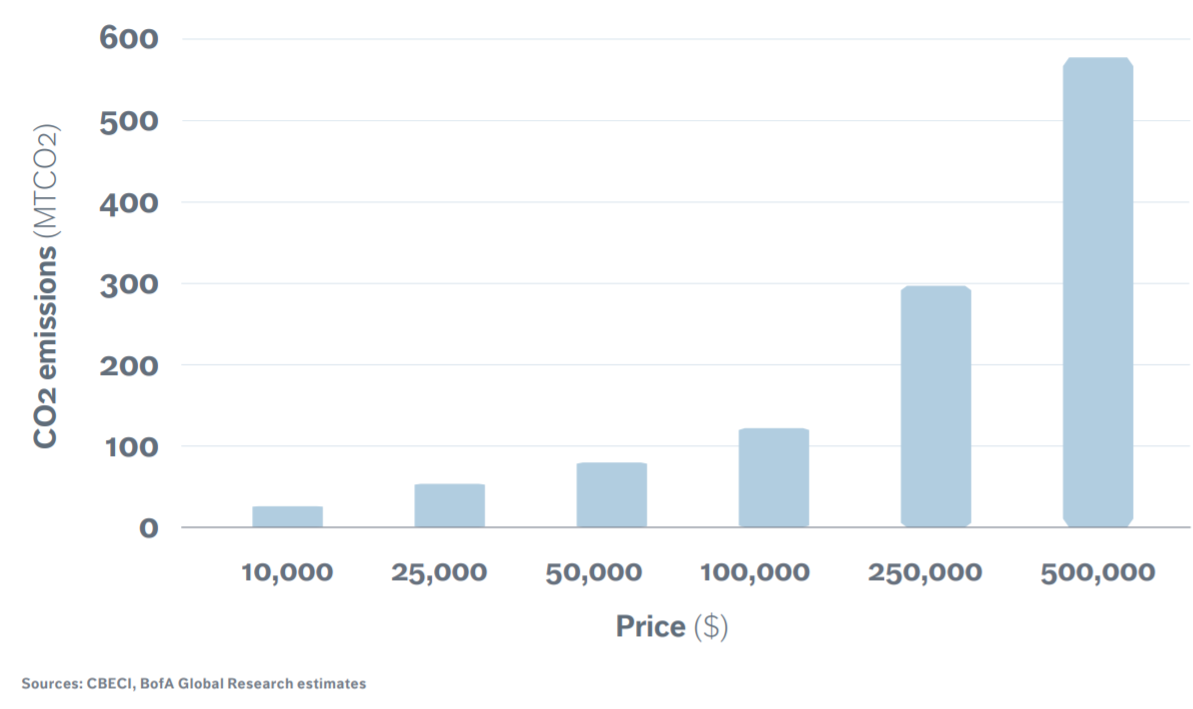The ESG credentials of cryptocurrencies took a hit following a series of damning headlines earlier this year, however, there may be light at the end of the tunnel for budding, ethical crypto investors, according to a recent report from Candriam.
The research, titled Cryptocurrencies and ESG: A contradiction in terms?, began by recounting the unsustainable and even illicit behaviours which many have come to be associate with digital assets.
For instance, citing research by the University of Cambridge, the report noted bitcoin uses around 0.4% of global energy consumption – more than Argentina or the Netherlands – as well as up to 150TWh of electricity per year, based on 2021 consumption.
In practical terms, this consumption is enough to run all kettles in the UK at their current level of usage for 29 years – but the problem is not how much energy bitcoin uses now, rather what it will use going forwards.
Not only do frothier valuations and greater familiarity with digital assets attract yet more speculative participants, but the persistence of larger cap currencies also mean they are being used either tactically or strategically by large financial institutions.
These factors, along with the influx of crypto exchange-traded products (ETPs) and loosening regulations, will likely act as long-term boons to crypto valuations, which, without change being enacted, will continue a vicious cycle of increased usage and corresponding rises in emissions.

Given the increasing complexity of the puzzles that need to be solved in proof-of-work (PoW) blockchain formats, many crypto miners look for the lowest-cost energy to power the ever-more powerful ‘rigs’ required to gain an edge over the competition.
Unfortunately, for most this means being agnostic towards the emissions produced by the cheapest energy source in any given location – something painfully illustrated by the closure of a single mine in Xinjiang province causing bitcoin’s hash rate to fall 20% in a week in April.
Thankfully, renewable energies – such as wind and solar – are currently the cheapest forms of electricity available in many parts of the world, and while the seasonal migration of crypto miners from China’s hydroelectric dams to coal mines illustrates the fluctuating supply of power from clean sources, advancements in battery technology will increasingly make this less of an issue.
Also, scaling up decentralised power generation will see localised and domestic clean energy hardware become more affordable – an attractive proposition for a community that values its autonomy.
Seeing the potential not only for miners to commit more firmly to using green power but expecting investors to support such actions, an American issuer launched the first ESG crypto ETF last week, the Viridi Cleaner Energy Crypto Mining & Semiconductor ETF (RIGZ), which allocates 80% towards miners who either use or have committed to rely on renewable energy, nuclear power or buy carbon credits.
Interestingly, CoinShares is a backer of Viridi and given its role in Europe – including partnering on the Invesco Elwood Global Blockchain UCITS ETF (BCHN) – it may only be a matter of time until we see a similar product come to market in Europe, helping to funnel capital towards more environmentally-conscious crypto miners.
A second way to address concerns corresponding to the ‘E’ pillar of ESG is for investors and miners to focus on so-called ‘non-mined’ digital assets, such as ripple, stellar, cardano, EOS and NEO.
Rather than using the energy-hungry PoW validation framework, these currencies rely on the proof-of-stake (PoS) process, which selects cryptocurrency owners to validate a block of transactions and selects one processor at random to process a transaction, rather than millions doing the same job simultaneously.
However, Candriam said under this form of peer verification, a few very large investors could get an overall control of making transactional records, which represents a significant governance issue.
“If an entity manages to buy 51% of all coins, then it can, in theory, hold the network and its stakeholders hostage,” the report stated. “In other words, a few major players could wield a lot of power within the PoS model, which simply would not be possible with PoW.”
While ‘whales’ hold the vast majority of all cryptocurrencies – even the mega caps – the larger assets will have a larger pool of whales making a PoS network power grab less likely. Fortunately, PoS is making inroads into the upper echelons of the crypto market, with ethereum announcing it will convert to PoS in its ethereum 2.0 update.
Are ‘S’ and ‘G’ concerns more intractable?
While often less fashionable than the environmental portion of ESG, there is arguably a longer lineage of social and governance issues in cryptocurrencies with their coveted anonymity and decentralisation attracting less-savoury actors who thrive off having a way to veil their activities.
Speaking on digital assets’ role in money laundering and shadow banking, the report said: “This can include the vast amounts of money stolen by corrupt regimes from their people, as well as illegal off-balance sheet transactions, enabling double accounting and shadow banking for terrorists.”
According to CipherTrace’s 2020 Cryptocurrency Crime and Anti-Money Laundering Report, major crypto thefts, hacks and frauds totalled $1.9bn – though the compliance service admitted this likely represents a small portion of what is actually laundering through cryptocurrencies given the most sophisticated criminals do not use criminally-linked addresses to launder their funds.
It is worth noting one of the selling points of digital assets – their ability to empower people with access to money transfers and investments – can also be called into question.
Aside from the fact that the world’s poor will have to have a smart phone and an internet connection to access crypto investments, converting crypto into fiat currency to buy goods and services comes with high costs attached.
More of a problem, however, is the potential for participants to walk away with a lot less money than they put into a crypto asset.
With UK and Swedish regulators already issuing public warnings about the volatility and dangers of crypto investment, Candriam pointed to recent events such as Elon Musk’s tirade against bitcoin and China’s new hard line on cryptocurrencies, which played a significant role in bitcoin’s value halving in the last two months.
The report also reflected on infamous scams base on crypto, such as Dr Ruja Ignatova’s OneCoin, which gathered ‘billions’ of dollars before going completely off the radar.
“In a more recent example, in June 2021, the US Justice Department said it seized approximately $2.3 m in bitcoins paid in ransom to hackers whose attack prompted the shutdown of the key East Coast pipeline,” the research continued. “Decentralised finance (DeFi) is the next major threat vector for fraud: half of all thefts in 2020, totalling $129m, were DeFi-related hacks.
“This threat looks to increase over the next few years as some centralised exchanges, such as Shapeshift, are transforming into decentralised exchanges to avoid compliance under the Know Your Customer (KYC) rules.”
While regulators such as the UK’s Financial Conduct Authority (FCA) remain suspicious of cryptocurrencies, there is often a rift between the right words and actions in tackling crypto fraud.
Some optimism can perhaps be drawn from the US Treasury’s statement that President Joe Biden wants to increase resource allocation to the US’s tax authorities to address cryptos’ role in “facilitating illegal activity broadly including tax evasion”.
Under the new proposal, businesses receiving crypto assets with a fair market value exceeding $10,000 will need to report them to tax authorities.
In a similar vein, Australian legislators are trying to incorporate cryptocurrencies within existing money laundering legislation, a move that, if successful, could lead to similar measures in other jurisdictions, the report said.
Theoretical solutions with questions left unanswered
Far from a roadmap for resolving the ESG shortcomings of crypto, the report offers solutions which have been suggested – and could be enacted – but at present remain largely hypothetical.
There is no guarantee investors across the world will be willing to pay a premium for ‘green’ crypto which at least initially will come at a higher cost to produce.
Similarly, while PoS is gaining prominence, bitcoin and its PoW framework remain dominant, with no hint it will change its mining algorithm or transaction validation any time soon.
Finally, with a glut of crypto ETP filings landing on the US regulator’s desk, there is no guarantee what will come first: important anti-money-laundering legislation, or another way for US investors to pile money into the asset class.
Though government legislation may not prove effective or go far enough, we can taken solace in the knowledge that cryptocurrency is perceived poorly in terms of ESG, meanwhile ESG is becoming a central concern for asset managers.
If the exponential growth of crypto relies on backing from big money institutional investors, it will probably have to clean up its act on ESG first.
Further reading



